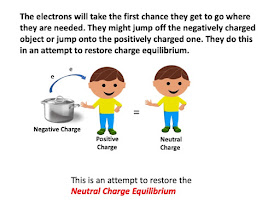
Students are given a variety of materials to explore. Instruct the students to blow up a balloon and see what materials they can get to stick to the balloon.
What did you discover about your balloon?
What objects responded to your balloon?
Is there anything you can do to your balloon to make it attract to some of the objects?
Does your balloon ever repel from some of the objects?
How is the balloon like a magnet? (like charges repel unlike charges attract)
Charged balloon is pushing away (repelling) the other balloon. Why?
Science and Engineering Practices
Planning and Carrying Out an Investigation
Constructing Explanations
Crosscutting Concepts
Cause and Effect
Stability and Change
Energy and Matter
Disciplinary Core Ideas
3-PS2-3 Motion and Stability: Forces and Interactions
Interactive Notebook Ideas
Background Information for Teachers
Static electricity is the build up of an electrical charge on the surface of an object. It's called "static" because the charges remain in one area for a while rather than moving or "flowing" to another area.
In our study of atoms we learned that atoms are made up of neutrons, protons, and electrons. The electrons are spinning around the outside. A static charge is formed when two surfaces touch each other and the electrons move from one object to another. One object will have a positive charge and the other a negative charge. Rubbing the items quickly, like when you rub a balloon fast over something or your feet on the carpet, will build up a large charge. Items with different charges (positive and negative) will attract, while items with similar charges (positive and positive) will push away from each other. Sort of like a magnet.
Remember when you've gone down a slide and all your hair stands up straight. This is because the friction of sliding has caused a positive charge to be built up on each hair. Since each hair has the same charge, they all try to push away from each other and end up standing up straight.
Likewise, when your skin is charged with static electricity and you touch something metal, like a door handle, the metal is very conductive and will quickly discharge the static electricity, creating a zap or small spark.
Or this great product Properties of Water Unit

















